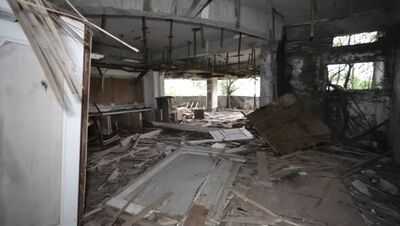
This luxury five-star hotel in Taoyuan, Taiwan, originally opened in 1976, but shut its doors in 2008 following financial troubles and shifts in tourist trends.
It was conceived as a highend fivestar resort with allinclusive amenities: suites, presidential accommodation, cafés, nightclubs, hotsprings/sauna areas, shops and recreation facilities. At its peak, the Sesame hotel served celebrities, politicians and affluent guests, leveraging the scenic mountain and waterview location near the reservoir. Today, the deserted property is shrouded in mystery. Elle Decor dubbed it Asia's most haunted hoteland ranked it the creepiest in the world, citing reports of an elevator that moves on its own. The decaying hotel now appears regularly in 'abandoned luxury' lists and has become a favourite destination for urban explorers, photographers, and fans of ghost stories.

The hotel has become a favourite spot for photographers, thrill-seekers, and ghost hunters. Every hallway seems to whisper secrets of its past, and the wind that whistles through broken windows carries the echoes of forgotten laughter and music.
The hotel opened with an investment of nearly £10million ($400million NT dollars) according to travel photography blog, Josh Ellis Photography.
The nine-story resort was considered cutting-edge at the time, but certain design choices were seen as unusual or even unlucky, according to Feng Shui principles.
One of the strangest features was its floor numbering system: the top floor was labeled the 'first floor,' while the ground level was called the 'eighth floor,' a choice that left visitors puzzled and added to the building's eerie mystique.
For many, the hotel is not just a site of architectural ruin, it is a portal to the past, frozen in a moment where luxury and tragedy collide.
Exploring the Sesame Hotel, however, is not without risk. The structure has suffered from years of neglect, and safety hazards are everywhere.
Second on Elle's list is the Holiday Inn in Beirut which opened in 1974, and was a symbol of modern luxury at the time, with 400 rooms, 26 floors, and the region's first rotating rooftop restaurant. With 360-degree views of the Mediterranean and a prime downtown location, it was part of the ambitious St. Charles City Center, which included shops, offices, a cinema, and a nightclub.
Designed by French architect André Wogenscky and Lebanese architect Maurice Hindié, the hotel promised a new era of tourism and business in Lebanon.
That promise was shattered in 1975 when the Lebanese Civil War erupted. The Holiday Inn quickly became a strategic stronghold in the infamous 'Battle of the Hotels,' as rival militias turned luxury high-rises into sniper nests and battlegrounds. Over 25,000 fighters clashed for control, resulting in more than 1,000 deaths, some reportedly from rooftop falls. By March 1976, the hotel was left a gutted, bullet-riddled shell.
The violence returned in 1982 during the Lebanon War, when militias again used the ruined tower as a battlefield. Today, ownership is split. One half is held by a Lebanese firm aiming to convert it into luxury condos, while the other half belongs to a Kuwaiti group planning demolition for a new development. Legal disputes and its strategic city-center location have left the hotel in limbo, now under the strict control of the Lebanese Army.
You may also like

Caldicot LIVE: 9-month-old baby dies in horror dog attack

BBC Antiques Roadshow expert reveals huge value of 'pulse raising' Pablo Picasso item

Pep Guardiola rages at referee and claims Man City get bad treatment

14-year-old girl offered lift in SUV, raped by 3

Smriti Mandhana Celebrates Historic ICC Women's World Cup Victory







